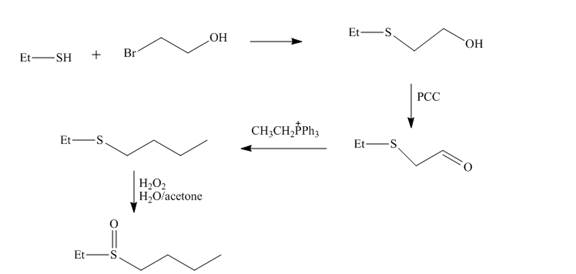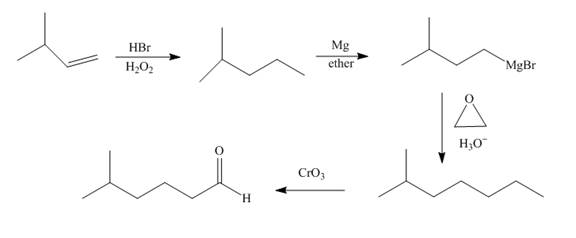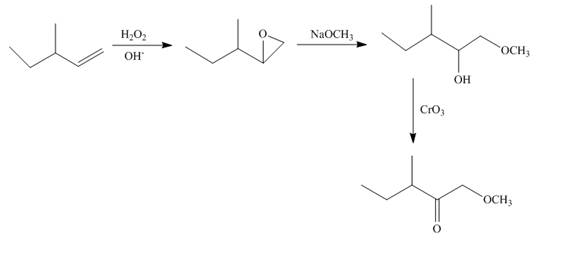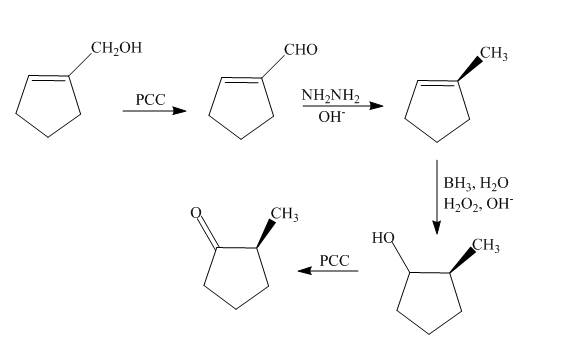
(a)
Interpretation:
The synthesis of
Concept introduction:
Oxymercuration reaction is a type of reaction in which an
Answer to Problem 11.61AP
The synthesis of

Explanation of Solution
The mercuric acetate

Figure 1
The route of synthesis of the formation of
(b)
Interpretation:
The synthesis of
Concept introduction:
The substances which on addition removes oxygen atom or hydrogen atom from the other substance, that is, reduces the other substances are known as reducing agents. Reducing agents themselves get oxidized. Strong reducing agents like
Answer to Problem 11.61AP
The synthesis of

Explanation of Solution
The treatment of

Figure 2
The route of synthesis of the formation of
(c)
Interpretation:
The synthesis of
Concept introduction:
Grignard reagents are
Answer to Problem 11.61AP
The synthesis of

Explanation of Solution
The reaction of tert-butyl bromide with

Figure 3
The route of synthesis of the formation of
(d)
Interpretation:
The synthesis of the given compound from the compounds that contain
Concept introduction:
Oxidation is the process in which there is an addition of oxygen atom or removal of hydrogen atom. The agents used for the oxidation reaction is known as oxidizing agents. It oxidizes the other substance and gets reduced in the reaction. The common oxidizing agents are nitric acid, oxygen and potassium dichromate.
Answer to Problem 11.61AP
The synthesis of the given compound from the compounds that contain

Explanation of Solution
The reaction of ethnethiol with

Figure 4
The synthesis of the given compound from the compounds that contain
(e)
Interpretation:
The synthesis of the given compound from an alkene is to be drawn.
Concept introduction:
Oxidation is the process in which there is an addition of oxygen atom or removal of hydrogen atom. The agents used for the oxidation reaction is known as oxidizing agents. It oxidizes the other substance and gets reduced in the reaction. The common oxidizing agents are nitric acid, oxygen and potassium dichromate.
Answer to Problem 11.61AP
The synthesis of the given compound from an alkene is shown below.

Explanation of Solution
The reaction of

Figure 5
The synthesis of the given compound from an alkene is shown in Figure 5.
(f)
Interpretation:
The synthesis of cyclohexyl isopropyl ether from cyclohexene is to be drawn.
Concept introduction:
Oxidation is the process in which there is an addition of oxygen atom or removal of hydrogen atom. The agents used for the oxidation reaction is known as oxidizing agents. It oxidizes the other substance and gets reduced in the reaction. The common oxidizing agents are nitric acid, oxygen and potassium dichromate.
Answer to Problem 11.61AP
The synthesis of cyclohexyl isopropyl ether from cyclohexene is shown below.

Explanation of Solution
The compound,

Figure 6
The synthesis of cyclohexyl isopropyl ether from cyclohexene is shown Figure 6.
(g)
Interpretation:
The synthesis of cyclohexyl isopropyl ether from cyclohexene is to be drawn.
Concept introduction:
Oxymercuration reaction is a type of reaction in which an alkene gets converted to alcohol. The mercuric acetate is used in the reaction as a reagent. This reagent attacks the alkene to form a cyclic intermediate compound which further undergoes reduction to form alcohol.
Answer to Problem 11.61AP
The synthesis of cyclohexyl isopropyl ether from cyclohexene is shown below.

Explanation of Solution
The mercuric acetate

Figure 7
The synthesis route of cyclohexyl isopropyl ether from cyclohexene is shown in Figure 7.
(h)
Interpretation:
The synthesis of the given compound from
Concept introduction:
Grignard reagents are organometallic compounds which are prepared using alkyl halides in the presence of magnesium metal in dry ether. These reagents act as strong nucleophiles and bases
Answer to Problem 11.61AP
The synthesis of the given compound from

Explanation of Solution
Bromination of alkene occurs with
Grigmard reagent reacts with the ethylene oxide followed by the hydrolysis to form an alcohol which upon oxidation by

Figure 8
The synthesis of the given compound from
(i)
Interpretation:
The synthesis of the given compound from
Concept introduction:
An
Oxidation is the process in which there is an addition of oxygen atom or removal of hydrogen atom. The agents used for the oxidation reaction is known as oxidizing agents. It oxidizes the other substance and gets reduced in the reaction. The common oxidizing agents are nitric acid, oxygen and potassium dichromate.
Answer to Problem 11.61AP
The synthesis of the given compound from

Explanation of Solution
Epoxidation of

Figure 9
The synthesis route of the given compound from
(j)
Interpretation:
The synthesis of the given compound from
Concept introduction:
An epoxide is cyclic ether. It can be prepare by the reaction of alkene with percarboxylic acid with removal of carboxylic acid. An epoxide undergoes ring opening reactions with an acid to give a product with inversion configuration.
Oxidation is the process in which there is an addition of oxygen atom or removal of hydrogen atom. The agents used for the oxidation reaction is known as oxidizing agents. It oxidizes the other substance and get reduced in the reaction. The common oxidizing agents are nitric acid, oxygen and potassium dichromate.
Answer to Problem 11.61AP
The synthesis of the given compound from

Explanation of Solution
Epoxidation of

Figure 10
The synthesis route of the given compound from
(k)
Interpretation:
The synthesis of given compound from the allyl chloride is to be drawn.
Concept introduction:
The nucleophilic substitution reactions depend upon the nucleophilicity and concentration of the nucleophile. There are two types of nucleophilic substitution reaction.
The
Answer to Problem 11.61AP
The synthesis of given compound from the allyl chloride is shown below.

Explanation of Solution
Allyl chloride reacts with

Figure 11
The synthesis of given compound from the allyl chloride is shown in Figure 11.
(l)
Interpretation:
The synthesis of the given compound is to be drawn.
Concept introduction:
Wolff Kishner Reduction is a reaction in which aldehydes and
Answer to Problem 11.61AP
The synthesis of the given compound is shown below.

Explanation of Solution
The reaction of cyclopentenyl methanol with

Figure 12
The synthesis of the given compound is shown in Figure 12.
(m)
Interpretation:
The synthesis of the given compound is to be drawn.
Concept introduction:
The substances which on addition removes oxygen atom or hydrogen atom from the other substance, that is, reduces the other substances are known as reducing agents. Reducing agents themselves get oxidized. Strong reducing agents like
Answer to Problem 11.61AP
The synthesis of the given compound is shown below.

Explanation of Solution
The alcohol is reduced in presence of

Figure 13
The synthesis of the given compound is shown in Figure 13.
Want to see more full solutions like this?
Chapter 11 Solutions
ORGANIC CHEMISTRY SAPLING ACCESS + ETEX
- Give a clear handwritten answer with explanation..complete the following reactions with their stereochemistry?arrow_forwardGive the clear handwritten answer and give the mechanism of given bleow reactionsarrow_forwardthe following reaction scheme leads to the formation of compound C. give the structure of the final product C and of the intermediate products A and B and justify, using the mechanism, the formation of the product A. Give the serereochemistry of the final product obtainedarrow_forward
- 2 Provide the structure(s) of the expected major organic product(s) (where appropriate) and provide a detailed, reasonable, arrow-pushing mechanism. Hint: In the presence of a-keto acids, NR3 selectively reacts with the keto motif - not the carboxylic acid end.arrow_forwardGive a clear handwritten answer with explanation..give the SN2 mechanism of given bleow reactionarrow_forwardGive a clear handwritten answer with explanation....give also textual explanation..give the name of product with explanation and give also product stereochemistry...?arrow_forward
- Give a clear handwritten answer with textual explanation..give the mechanism of given bleow reactionsarrow_forwardGive the structure of a, b, c, d and e in clear handwritten?arrow_forwardGive only typing answer with explanation and conclusion What is the main product formed in the Friedel-Crafts alkylation reaction of benzene with 1-butene and AlCl3?arrow_forward
- Give a clear handwritten answer..and give the mechanism of given bleow reactionarrow_forwardWhich compound (i or ii) is the stronger base? Discuss your answer comprehensively by amoungst other providing an acid base reaction for one of the compounds.arrow_forwardProvide the synthesis of 2-bromo-4-nitrophenyl from aniline. (structures). With explanation need.arrow_forward
 Organic ChemistryChemistryISBN:9781305580350Author:William H. Brown, Brent L. Iverson, Eric Anslyn, Christopher S. FootePublisher:Cengage Learning
Organic ChemistryChemistryISBN:9781305580350Author:William H. Brown, Brent L. Iverson, Eric Anslyn, Christopher S. FootePublisher:Cengage Learning EBK A SMALL SCALE APPROACH TO ORGANIC LChemistryISBN:9781305446021Author:LampmanPublisher:CENGAGE LEARNING - CONSIGNMENT
EBK A SMALL SCALE APPROACH TO ORGANIC LChemistryISBN:9781305446021Author:LampmanPublisher:CENGAGE LEARNING - CONSIGNMENT

